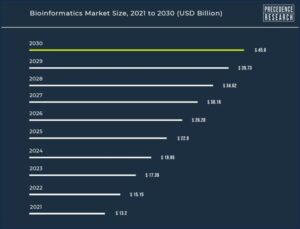When you’re looking to land a good bioinformatics job, whether you’re a fresher, a career changer, or an experienced candidate, there’s usually a lot on your mind. And although the job search phase can look intimidating and exhausting, there has never been a better time to start a career in the niche.
The Bureau of Labor Statistics predicts that job growth will occur in the field of bioinformatics at a rate of 15% through the end of the 2020s, which is a lot faster than the average growth for all jobs in the US.

Source: Globe Newswire
So then, how exactly can data science candidates leverage this increase in demand to their favor?
The answer is simple! By targeting the right position — this will help you narrow down your search and figure out what skills you most need to attract good job openings in the market.
How to Choose the Right Bioinformatics Position?
Today, there are a number of bioinformatics profiles to choose from. All of them are critical to making important business decisions. Often, several of these job types work together on the same team.
Before we can look at the factors you should be considering to choose the right bioinformatics position, let us first get to know about a few skills that are in high demand within the niche today. Learning this will increase your chances of landing a good data science position by manifolds.
Bioinformatics Skills in Demand:
Experts agree that the most successful bioinformaticians (and the ones who land the jobs) are those who have a multitude of skills. But the starting point is always knowledge of life sciences, also referred to as domain expertise in the industry.
In fact, “the deeper you understand the biology, the better you do your job in this area,” says W. Jim Zheng, associate professor in the School of Biomedical Informatics at The University of Texas Health Science Center at Houston.
Hiring managers specifically seek out scientists who have doctorates in various areas of life sciences, including molecular and cellular biology, chemistry, genetics, immunology, and epidemiology.
Other critical bioinformatics skills that are in great demand today include:
- Statistical Analysis – The ability to perform statistical analysis with tools like Python and R, as well as knowledge of statistical software systems like SPSS and SAS will take you a long way in landing the bioinformatics role you’ve been eyeing.
- Basic Coding and Programming Knowledge – If you want to land a good job with a good company, it is important that you learn commonly used programming languages, some of which include Python, R, Perl, C/C++, Java, etc.
- Common Bioinformatics-related Tools – The understanding of how biological systems (and their related components) work is at the apex of bioinformatics. This is why knowledge of commonly used bioinformatics tools that help with better understanding these systems is an important skill to have on your resume if you want to attract the best employers.
- Machine Learning Techniques – Today, various ML algorithms are being extensively used tasks to perform tasks such as prediction, classification, and feature selection in bioinformatics. Therefore, having basic understanding of, or some amount of prior experience with machine learning algorithms and techniques can considerably increase your chances of being discovered by good companies.
- General Soft Skills – Research conducted by Harvard University, the Carnegie Foundation and Stanford Research Center has all concluded that 85% of job success comes from having well‐developed soft and people skills. Therefore, honing general soft skills can take you a long way in landing the job of their dreams.
Bioinformatics Job Titles in Demand:
1) Bioinformatics Scientist
The key responsibility of a bioinformatics scientist is to develop databases and software applications to analyze biological data and extract valuable information from it.
Coordinating with other professionals and scientists within the organization is a crucial skill for this role. Maintaining extensive records of analyses and experiments is also an integral part of a bioinformatics scientist’s job, especially because it allows for easy review of past work to decide upon future research priorities.
Other components of the day-to-day may differ depending on where you work and what’s your team size.
Average Salary in the US – $97,404
2) Research Scientist
A research scientist typically conducts research in a laboratory setting that includes both experimental groups and control. An academic or professional background in bioinformatics is helpful for interpreting the results of an experiment, such as for summarizing observations in scientific papers, and collecting data from tests conducted on living specimens.
Since research scientists often conduct work that is not immediately or directly applicable to the business world, fundraising and grant-writing are useful skills for this bioinformatics role.
Average Salary in the US – $83,565
3) Biostatistician
This role usually focuses on statistical design and analysis as it relates to research work.
A biostatistician is also responsible for preparing reports that summarize the analysis and refer to any pertinent research methodologies. The work environment may either be a research lab or a hospital, and the areas of focus may be genetics, epidemiology, or ecology.
The ability to create easy-to-read reports is a critical skill for a biostatistician, as the analysis is often presented to clients or other external stakeholders in addition to internal teams. The role is typically part of a larger research team, so interpersonal management and collaboration are also valuable skills.
Average Salary in the US – $77,665
4) Microbiologist
This role focuses on how organisms such as viruses and bacteria interact with the environment, and impact both animal and human health.
Because microbiologists typically work in an academic setting, an advanced degree is often required to supervise students or other lab professors, or conduct independent research in general.
A background in bioinformatics can help microbiologists interpret anomalies and other patterns in their research data, which in turn can be used to identify areas of additional research or discover new ways that an organism may impact our health. In addition, since publishing scientific articles or papers is an important part of a microbiologists’ work, understanding how to display data and analyze it in an approachable way is a key part of the role.
Average Salary in the US – $79,260
5) Bioinformatician
A bioinformatician is responsible for developing data frameworks, managing large databases, and creating and modifying algorithms. Their analysis is typically used for classifying components of a biological system such as documenting protein expression or DNA sequences.
Bioinformaticians should be well-versed in combining data sets, programming statistical models, and maintaining data security and integrity. Individuals in this role also often collaborate with scientists and researchers to interpret and present data sets.
Average Salary in the US – $74,434
6) Wildlife Biologist or Zoologist
These scientists study animals that are visible to the naked eye, whether it’s a single species or a larger group of animals. Work is often done in the field to observe how animals interact with each other, their surrounding environment, and with human populations.
Zoologists or wildlife biologists are often employed by public agencies, universities, or private firms focused on conservation or farm protection. Non-standard work hours are common.
Data collection and analysis play a big part in this work, whether gathering specimens, studying migration patterns, or examining satellite and climate data. Knowledge of bioinformatics supports zoologists and wildlife biologists in conducting more in-depth analyses of population models, genetics, or the impact of habitat change.
Average Salary in the US – $64,650
7) Molecular Biologist
A molecular biologist looks at individual cells and molecules in plants, animals, and humans, paying particular attention to how they interact.
Individuals in this role typically work at a hospital, university, laboratory, or government agency, though some may work in a corporate setting. This research is often used to diagnose and treat diseases at a molecular level, particularly those caused by inherited genetic mutations.
Bioinformatics skills are helpful for the role of the molecular biologist due to the size of the human genome (more than 3 billion pairs of nucleotide bases) and the human proteome, or set of proteins in the human body (estimated at more than 20,000 combinations of up to 20 different amino acids). In addition, the ability to analyze text, images, or sound files can help molecular biologists generate results from large sets of raw data.
Average Salary in the US – $62,478
Choosing the Right Bioinformatics Position:
While it is true that every individual is different and your interests play a crucial role in deciding which company and bioinformatics job title you choose, we’ll take a more objective approach here and provide suggestions that’ll help you choose a position solely on the basis of your background.
1) If You Have a Couple Years of Experience in Bioinformatics
Say you’re already a bioinformatics candidate with a few years of experience and are looking for a job either because you want to work in a different field, or because you want to switch to a different company.
In such a case, all types of bioinformatics roles would be ideal for you. All you need to do is demonstrate relevant industry experience and show your potential employer why you’re a good fit for their organization, even from the company culture perspective.
2) If You’re Employed with a Startup and Want to Advance to Bigger Companies
In this scenario, the position that you land will largely depend on your existing experience and skillset.
Say, for example, you have been working in a startup on the analytics track for 3 years. If you want to continue on the same track but switch to a bigger public company, you would have a very high chance of landing interviews because you have the exact experience they are looking for.
Now consider a second scenario where you want to change to the biologist track from your existing analytics track. You still have a high chance of landing a good job position if you have first-hand experience/can demonstrate that you have been an active part of projects related to that role.
3) If You’re a Fresh Graduate
In this case, the right type of position will largely depend on the coursework you have done.
Generally speaking, if you majored as a bioinformatician or you have taken many statistics courses, or if you graduated from a business school but have taken courses related to bioinformatics, then the analytics track may be the best choice for you.
On the other hand, if you have taken extensive research-related courses, then non-business focused roles are probably going to be the best for you.
4) If You’re Wanting to Switch Careers and Pivot to Bioinformatics
In this case, it’ll help to focus on the business-driven roles.
There are two reasons for this —
- the number of openings for the analytics track is the highest in any field.
- if you already have some experience in the industry, product knowledge and business metrics may become very intuitive for you, which is a key requirement for the analytics track. This would make your transition much smoother.
You can also go for a research-based position if you have a passion for it and you have taken the time to build a strong foundation there.
That’s a wrap!
To learn more about how you can increase your chances of getting noticed by the best companies and land the bioinformatics position you’ve been eyeing for long, get in touch with us at BenchPoint – top HealthTech IT recruitment agencies!
We’ll be happy to guide you in your job search and help you build a strong background in the process of doing so.
